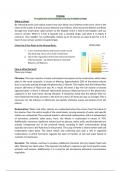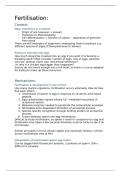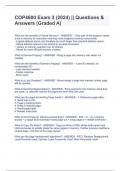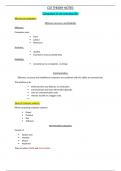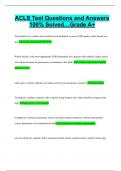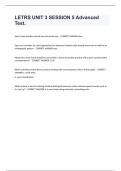Urology
P7. Explain how urine composition may vary in relation to health
What is Urine?
By removing toxins and surplus water from your blood, your kidneys create urine. Urine is the
name of the waste. It travels via your blood to your kidneys. Urine leaves the kidneys and flows
through two small tubes called ureters to the bladder. Urine is held in the bladder until you
need to urinate. When it is full, it expands into a rounded shape, and when it is empty, it
contracts. Your bladder can comfortably contain up to 16 ounces (2 cups) of pee for 2 to 5
hours if your urinary system is in good shape.
Urine Has 2 Key Roles in the Human Body:
1. Carry waste products and excess water out of
the body (eg: Urea, Uric Acid, Creatinine).
2. Aid in the regulation of the internal environment
(Homeostasis) - eg: Water Balance, Osmotic
Balance, pH Balance.
How is Urine Formed?
There are 4 steps:
Filtration: The mass transfer of water and solutes from plasma to the renal tubule, which takes
place in the renal corpuscle, is known as filtering. Approximately 20% of the plasma volume
that is currently passing through the glomerulus is filtered. This implies that the kidneys filter
around 180 litres of fluid each day. As a result, 60 times a day the full volume of plasma
(approximately 3 litres) is filtered! Hydrostatic pressure (blood pressure) in the glomerulus'
capillaries is the main factor driving filtration. It should be noted that the kidneys filter far
more fluid than the body excretes in the form of urine (1.55 litres per day on average). This is
necessary for the kidneys to effectively and quickly eliminate waste and poisons from the
plasma.
Reabsorption: Water and other solutes are reabsorbed when they return from the tubule to
the plasma. Over the entire length of the renal tubule, varying amounts of water and specific
solutes are reabsorbed. The proximal tubule is where bulk reabsorption, which is independent
of hormones, primarily takes place. Here, the filtrate is reabsorbed in excess of 70%.
Additionally, numerous significant solutes (such as glucose, amino acids, and bicarbonate) are
actively transported out of the proximal tubule, resulting in their concentrations being
typically very low in the fluid that is still present. The Loop of Henle is where further bulk salt
reabsorption takes place. The distal tubule and collecting duct play a role in regulated
reabsorption, in which hormones regulate the pace of transfer of salt and water based on
systemic circumstances.
Secretion: The tubules continue to produce additional chemicals into the tubular fluid even
after filtering has taken place. This improves the kidney's capacity to get rid of specific waste
products and poisons. Additionally, it is crucial for pH and plasma potassium concentration
regulation.
, Excretion: The consequence of the aforementioned three procedures is excretion, which is
what is excreted in the urine. Although a substance's initial concentration in the tubule fluid
may be similar to its plasma-like initial concentration, subsequent reabsorption and/or
secretion can significantly change the final concentration in the urine. This is the body
adjusting what will be excreted and, if necessary, harvesting back what it needs.
Explain what changes to these normal values might indicate in terms of the normal functioning of the body
systems (due to diet, lifestyle, medication) and the patient’s health
Urine contains solutes, or soluble particles. Urine would have the same specific gravity as
water, 1.000, if these particles weren't present. The amount of particles in a person's urine
relative to water is determined by its specific gravity. As the amount of particles in the urine
increases, the pee specific gravity rises. If there are more particles in urine than there are in
water, it will be denser and have a higher specific gravity. Examples of the kinds of particles
detected in urine include glucose, proteins, and ketones.
Urea, a kidney-produced waste product, is expelled when you urinate. By measuring the
amount of urea in the urine, the urine urea nitrogen test evaluates how much protein is broken
down. The test can reveal whether or not your kidneys are functioning properly and whether
or not you are consuming too much or too little protein. Additionally, it might assist you in
determining whether intestinal absorption or protein digestion are issues for you. The hCG
urine test examines whether the hCG hormone is present in your urine and is a qualitative test.
It is not intended to reveal specific hormone levels. One indication that you are pregnant is the
presence of hCG in your urine. If the amount of sodium in a sample of your urine is within
normal ranges, it can be determined by a urine sodium test. A problem with your kidneys or
another health issue could be indicated by too much or too little salt consumption.
Milliequivalents per litre (mEq/L) will be used to express your results. Your lab's standard value
might differ somewhat from this. The typical urine salt concentration for a single urine sample
is around 20 mEq/L. A 24-hour urine test's typical range is 40 to 220 mEq/L each day. The wide
range reflects your daily salt intake.
Urine testing is known as a urinalysis. It is used to identify and treat a number of diseases, such
as diabetes, renal disease, and urinary tract infections. During a urinalysis, the appearance,
concentration, and substance of the urine are all inspected. For instance, urine that has a
urinary tract infection may seem cloudy rather than clear. Protein levels that are higher in the
urine can signify renal impairment. The urine is put onto a dipstick, a little plastic stick with
chemical stripes on it. The chemical strips will change colour if certain substances are present
or if their levels are higher than normal. When using a dipstick, the following are looked for:
● pH Astringency: The pH value affects how much acid is present in the urine. A high pH
level might mean you have a kidney or urinary tract problem.
● Concentration: A concentration measurement indicates how concentrated the
particles in your urine are. Not drinking enough fluids is a common cause of a
higher-than-normal concentration.
● Protein: Protein levels in the urine are usually low. Protein in urine in little levels is
normally not a reason for concern, but bigger amounts might suggest a kidney disease.
● Sugar: Sugar (glucose) levels in urine are usually too low to be detected. Any sugar
found on this test typically necessitates further diabetic testing.
P7. Explain how urine composition may vary in relation to health
What is Urine?
By removing toxins and surplus water from your blood, your kidneys create urine. Urine is the
name of the waste. It travels via your blood to your kidneys. Urine leaves the kidneys and flows
through two small tubes called ureters to the bladder. Urine is held in the bladder until you
need to urinate. When it is full, it expands into a rounded shape, and when it is empty, it
contracts. Your bladder can comfortably contain up to 16 ounces (2 cups) of pee for 2 to 5
hours if your urinary system is in good shape.
Urine Has 2 Key Roles in the Human Body:
1. Carry waste products and excess water out of
the body (eg: Urea, Uric Acid, Creatinine).
2. Aid in the regulation of the internal environment
(Homeostasis) - eg: Water Balance, Osmotic
Balance, pH Balance.
How is Urine Formed?
There are 4 steps:
Filtration: The mass transfer of water and solutes from plasma to the renal tubule, which takes
place in the renal corpuscle, is known as filtering. Approximately 20% of the plasma volume
that is currently passing through the glomerulus is filtered. This implies that the kidneys filter
around 180 litres of fluid each day. As a result, 60 times a day the full volume of plasma
(approximately 3 litres) is filtered! Hydrostatic pressure (blood pressure) in the glomerulus'
capillaries is the main factor driving filtration. It should be noted that the kidneys filter far
more fluid than the body excretes in the form of urine (1.55 litres per day on average). This is
necessary for the kidneys to effectively and quickly eliminate waste and poisons from the
plasma.
Reabsorption: Water and other solutes are reabsorbed when they return from the tubule to
the plasma. Over the entire length of the renal tubule, varying amounts of water and specific
solutes are reabsorbed. The proximal tubule is where bulk reabsorption, which is independent
of hormones, primarily takes place. Here, the filtrate is reabsorbed in excess of 70%.
Additionally, numerous significant solutes (such as glucose, amino acids, and bicarbonate) are
actively transported out of the proximal tubule, resulting in their concentrations being
typically very low in the fluid that is still present. The Loop of Henle is where further bulk salt
reabsorption takes place. The distal tubule and collecting duct play a role in regulated
reabsorption, in which hormones regulate the pace of transfer of salt and water based on
systemic circumstances.
Secretion: The tubules continue to produce additional chemicals into the tubular fluid even
after filtering has taken place. This improves the kidney's capacity to get rid of specific waste
products and poisons. Additionally, it is crucial for pH and plasma potassium concentration
regulation.
, Excretion: The consequence of the aforementioned three procedures is excretion, which is
what is excreted in the urine. Although a substance's initial concentration in the tubule fluid
may be similar to its plasma-like initial concentration, subsequent reabsorption and/or
secretion can significantly change the final concentration in the urine. This is the body
adjusting what will be excreted and, if necessary, harvesting back what it needs.
Explain what changes to these normal values might indicate in terms of the normal functioning of the body
systems (due to diet, lifestyle, medication) and the patient’s health
Urine contains solutes, or soluble particles. Urine would have the same specific gravity as
water, 1.000, if these particles weren't present. The amount of particles in a person's urine
relative to water is determined by its specific gravity. As the amount of particles in the urine
increases, the pee specific gravity rises. If there are more particles in urine than there are in
water, it will be denser and have a higher specific gravity. Examples of the kinds of particles
detected in urine include glucose, proteins, and ketones.
Urea, a kidney-produced waste product, is expelled when you urinate. By measuring the
amount of urea in the urine, the urine urea nitrogen test evaluates how much protein is broken
down. The test can reveal whether or not your kidneys are functioning properly and whether
or not you are consuming too much or too little protein. Additionally, it might assist you in
determining whether intestinal absorption or protein digestion are issues for you. The hCG
urine test examines whether the hCG hormone is present in your urine and is a qualitative test.
It is not intended to reveal specific hormone levels. One indication that you are pregnant is the
presence of hCG in your urine. If the amount of sodium in a sample of your urine is within
normal ranges, it can be determined by a urine sodium test. A problem with your kidneys or
another health issue could be indicated by too much or too little salt consumption.
Milliequivalents per litre (mEq/L) will be used to express your results. Your lab's standard value
might differ somewhat from this. The typical urine salt concentration for a single urine sample
is around 20 mEq/L. A 24-hour urine test's typical range is 40 to 220 mEq/L each day. The wide
range reflects your daily salt intake.
Urine testing is known as a urinalysis. It is used to identify and treat a number of diseases, such
as diabetes, renal disease, and urinary tract infections. During a urinalysis, the appearance,
concentration, and substance of the urine are all inspected. For instance, urine that has a
urinary tract infection may seem cloudy rather than clear. Protein levels that are higher in the
urine can signify renal impairment. The urine is put onto a dipstick, a little plastic stick with
chemical stripes on it. The chemical strips will change colour if certain substances are present
or if their levels are higher than normal. When using a dipstick, the following are looked for:
● pH Astringency: The pH value affects how much acid is present in the urine. A high pH
level might mean you have a kidney or urinary tract problem.
● Concentration: A concentration measurement indicates how concentrated the
particles in your urine are. Not drinking enough fluids is a common cause of a
higher-than-normal concentration.
● Protein: Protein levels in the urine are usually low. Protein in urine in little levels is
normally not a reason for concern, but bigger amounts might suggest a kidney disease.
● Sugar: Sugar (glucose) levels in urine are usually too low to be detected. Any sugar
found on this test typically necessitates further diabetic testing.

